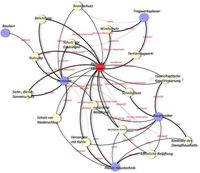Complexity management in the parametric-associative assisted structural design in building construction
The structural design process is characterized by interactions between planning domains. This work aims to develop a concept for handling the complexity of process dependencies. Based on the requirements analysis of the process, opportunities are sought to build a holistic parametric and associative design system. The benefits and risks are presented, implemented and evaluated. Through the developed concept, it is possible to reduce design risk and gain a deeper understanding of the relationships of structural design in building construction.
Doctoral Thesis
Chair of Structural Design
by André Ihde
The structural design process for building construction is characterized by strong interactions between the different planning domains. The complexity of planning is directly dependent on the quantity, quality and temporal development of planning interactions. The aim of this work is to develop concepts for handling the complexity of and gain deeper insights into process dependencies.
Based on the requirements analysis of the planning process, opportunities are sought to build a holistic, flexible, parameterized planning system. The requirements analysis is based initially on personal project experience and is broadened by a qualitative survey in the field of structural design, and related engineering disciplines. In searching for adequate approaches, papers from the field of Architecture and Construction Informatics have been analyzed. This work focuses on possible ways to adapt and develop these analyses toward the structural design process. Further, available software packages have been assessed for their performance possibilities in the field of complexity management. Based on the research results, the idea of the structuring and coupling of Domain-Specific sub-models is pursued. These linked domain-abstractions simulate the planning workflow. Concepts of detection and visualization of multiple domain interactions are sought and discussed using related models. The expected benefits and risks of a parametric-associative design system are presented, implemented and evaluated synoptically. Through the developed concept, it is possible to reduce design risk and to gain a deeper understanding of the relationships of structural design in building construction.
